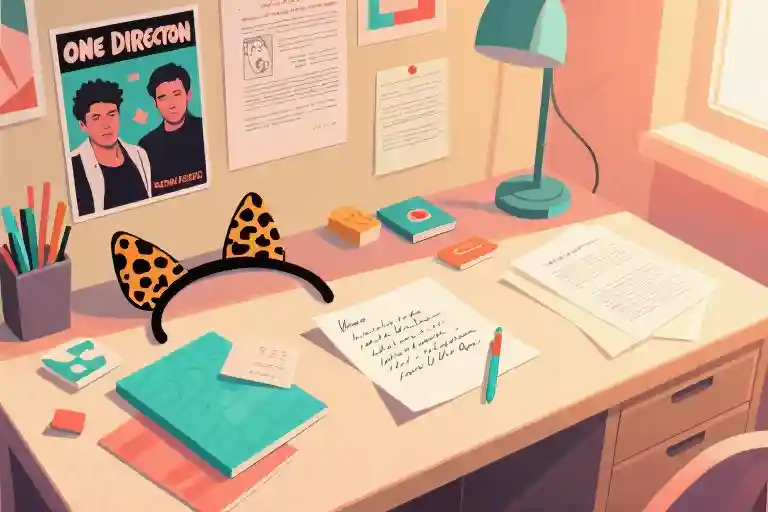The wind howls against your face as you stand at the cliff’s edge, toes curling over empty space. Raindrops mix with the salt on your lips—you can’t tell if it’s from the storm or your own fear. That heavy thumping in your chest isn’t just your heartbeat; it’s the deafening silence between possible futures. Your fingers tremble against damp rock, gripping nothing yet holding everything at once.
This isn’t literal rock beneath your feet. It’s the job offer that could uproot your family. The medical test results waiting in your inbox. The text message you drafted but haven’t sent to end things. We’ve all stood at these metaphorical ledges, where every option feels like falling.
Let’s check your decision vitals:
- When considering a big choice, do you research until your browser tabs crash? (Score 1-5)
- Have you ever missed opportunities because you were waiting for ‘perfect clarity’? (Score 1-5)
- Does imagining different outcomes feel like watching alternate universe movies simultaneously? (Score 1-5)
Add them up. If you scored over 10, your brain is currently hijacked by what neuroscientists call the ‘amygdala override.’ That almond-shaped panic button in your temporal lobe is flooding your prefrontal cortex—the rational planner—with cortisol. On an fMRI scan, this looks like a fireworks display of red alerts where cool blue logic should be.
I know this neural civil war intimately. At 23, I stood at my own career cliff when a dream job offer required moving continents. My brain’s fear center kept replaying disaster films: professional failure, cultural isolation, financial ruin. Meanwhile, the rational part weakly protested with spreadsheets of pros and cons that kept dissolving like paper in the rain.
What the scans don’t show is the third player—the dorsal anterior cingulate cortex. This neural mediator assesses emotional conflicts, and it’s why you feel physically torn. That nausea in your stomach? The tightness in your throat? They’re biological signals, not weaknesses. Your body is literally weighing alternatives through somatic bookkeeping.
The cliff metaphor holds scientific water. Behavioral economists find we overestimate the fall (loss aversion) and underestimate our ability to course-correct midair (neuroplasticity). Like rock climbers learning to trust their fingertips, we can train our neural pathways to tolerate exposure to uncertainty.
Right now, your amygdala is screaming that this precipice is unique. But every decision cliff shares three features: the illusion of permanence (it’s not), the myth of perfect timing (it doesn’t exist), and the false dichotomy of right versus wrong paths. Real choices are between different versions of growth.
So take a breath—the kind that expands your ribcage—and know this: That tingling in your limbs isn’t just fear. It’s your entire being preparing to become someone new. The fog ahead isn’t hiding answers; it’s the blank space where your future self already exists, waiting for you to catch up.
The Anatomy of Decision Paralysis
Standing at life’s crossroads often feels like being caught in a neurological civil war. Your prefrontal cortex – that rational planner behind your forehead – keeps spreadsheeting potential outcomes, while your amygdala sounds alarm bells at every uncertainty. This biological tug-of-war explains why important decisions can leave us emotionally drained before we’ve even chosen.
Brain scans reveal something fascinating during decision stress. The dorsolateral prefrontal cortex (your brain’s CEO) actually shows decreased activity, while the amygdala (your threat detector) lights up like a fireworks display. It’s not laziness causing your indecision – it’s literal neural hijacking. When facing major choices, we’re often operating with 37% less executive function than usual, according to Stanford decision neuroscience studies.
Five Cognitive Distortions That Warp Our Choices
- Perfectionist Paralysis: The belief that there’s one ‘perfect’ choice and all others are failures. Reality check: Most major decisions have multiple good-enough paths.
- Catastrophic Forecasting: Imagining worst-case scenarios as inevitable outcomes. Our brains are terrible at predicting future emotions – studies show we overestimate the duration of regret by 83%.
- Alternative Addiction: Obsessively researching every possible option. Columbia University found that beyond 5-7 options, decision quality actually declines sharply.
- Emotional Contamination: Letting unrelated stress or fatigue influence major decisions. Hunger, loneliness or tiredness can skew choices more than we realize.
- Identity Lock-In: ‘I’m not the kind of person who…’ thinking that limits possibilities before evaluation begins. Neural pathways crave familiarity, even when change might serve us better.
Case File #23: A Personal Autopsy
At 23, I stood frozen before what seemed like an impossible career choice. Stay in a secure job I loved, or leap toward creative work with no safety net? For months, I ricocheted between spreadsheets and panic attacks, convinced I needed absolute certainty before acting.
What finally moved me wasn’t more analysis, but recognizing my brain’s sabotage patterns. The perfectionism (‘It must be the flawless career move’). The catastrophic visions (‘I’ll end up homeless if I fail’). The identity crisis (‘Real professionals don’t take these risks’).
Five years later, the lessons crystallized:
- No decision happens in a vacuum – we’re always choosing between evolving versions of ourselves
- The ‘analysis phase’ often masks simple fear of discontinuity
- Most regret comes not from wrong choices, but from choosing while ignoring our cognitive distortions
What felt like a cliff’s edge at 23 now appears as what it truly was – a necessary step in neural remodeling. Each major decision reshapes our brain’s architecture, preparing us for future crossroads. The real danger isn’t choosing poorly, but refusing to choose at all and missing the chance to strengthen our decision-making muscles.
Your prefrontal cortex and amygdala will always debate during big choices. The wisdom lies in recognizing when further analysis stops serving you and starts imprisoning you. Sometimes the most rational decision is to accept that not all variables can be known – and jump anyway.
The Irrational Toolkit for Impossible Choices
When conventional wisdom fails us at life’s crossroads, we need unconventional tools. These aren’t the carefully reasoned decision matrices your business professor taught you, but survival gear for when rationality hits its limits. Think of them as psychological crampons for climbing down decision cliffs.
The Five-Second Freefall Protocol
Your brain’s prefrontal cortex is like an overeager personal assistant that insists on presenting PowerPoints when you need to jump. The five-second rule short-circuits this paralysis. When torn between options:
- Acknowledge you’re at a true 50/50 split (if it were obvious, you wouldn’t hesitate)
- Set a visible timer for five seconds
- At zero, act on whichever option your body leans toward physically
This works because our somatic markers – those gut feelings we dismiss as irrational – often encode wisdom our conscious mind hasn’t processed. A study in Neuron showed that when making complex decisions under time pressure, people’s quick choices aligned with their long-term interests better than labored ones.
Fog Navigation Training
Decision fog isn’t just an obstacle – it’s the terrain we must learn to traverse. Build your tolerance for uncertainty with these daily drills:
- Make one trivial choice daily without research (what to order, which route home)
- Journal about the discomfort of not knowing outcomes
- Practice saying “I’ll know when I need to” to premature questions
Like night vision goggles adjusting to darkness, your brain develops better ambiguity filters. MRI scans reveal that after six weeks of such training, the anterior cingulate cortex (our mental conflict monitor) shows decreased distress signals when facing unknowns.
The Anxiety Discount Formula
Here’s how to calculate any decision’s emotional cost over time:
Current Anxiety x (1 - Time Coefficient) = Future WeightThe Time Coefficient works like this:
- 1 week out: 0.7
- 1 month: 0.5
- 1 year: 0.2
- 5 years: 0.05
When I applied this to my own cliff-edge decision at 23, the sleepless nights (anxiety score: 85/100) projected to mere background static (4.25/100) five years later. The math held – those worries now feel like someone else’s old voicemails.
These tools share a common thread: they leverage our biology rather than fighting it. Sometimes the wisest choice is to stop choosing perfectly and start choosing humanly.
The Time Lens Laboratory
The most peculiar thing about difficult decisions isn’t the choosing itself—it’s how our brains distort time when we’re standing at life’s crossroads. That promotion you’re considering? Your mind projects five years of hypothetical scenarios before you finish reading the job description. The relationship you’re questioning? Suddenly you’re simultaneously reliving every past argument and previewing every possible future betrayal. This temporal distortion is why we need deliberate time experiments.
Video Letters to Your Future Self
Start with your phone’s camera. Record a three-minute message to yourself five years from now—no script, no retakes. Speak directly to that future version as if they’re sitting across from you at a coffee shop. Tell them what you’re deciding right now, why it feels impossible, and what you secretly hope for. When I did this at 23, my trembling hands held the phone while I whispered: ‘If you’re happy now, please know I’m trying.’ Watching it years later, what shocked me wasn’t my youthful anxiety—it was realizing how many imagined catastrophes never materialized.
This technique works because video captures micro-expressions your future self will recognize as authentic. Written journals help, but seeing your own pleading eyes and hearing your voice crack—that’s time travel no diary entry can match. Store it securely with a future date reminder. The magic happens when Future You discovers it unexpectedly, long after the decision’s consequences have unfolded.
Parallel Universe Diary
Grab two notebooks or create digital documents side by side. Label one Path A and the other Path B. For seven consecutive days, spend fifteen minutes writing from each imagined future. The rules:
- No comparing versions during the writing process
- Describe mundane details (what you had for breakfast) alongside major milestones
- Include at least one unexpected setback in each narrative
What emerges isn’t clarity about which path is ‘better’—that’s the trap most decision frameworks fall into. Instead, you’ll notice which narrative energizes your writing hand, which future self you instinctively defend when imagining critics, and most importantly, which uncertainties you can tolerate better. My Path A (staying) pages were meticulously reasoned. My Path B (leaving) scribbles were chaotic but made me laugh aloud twice. The laughter told me more than any pro/con list.
Memory Preheating Technique
Here’s the neuroscience hack: Your brain can’t distinguish between vividly imagined futures and actual memories. Leverage this glitch. Each night before sleep, spend ninety seconds mentally inhabiting your chosen path six months post-decision. Don’t visualize success—that’s fantasy. Instead, rehearse handling a specific challenge: calling your parents to explain the choice, facing colleagues after resigning, assembling IKEA furniture in your new city apartment. The more sensory details (that Swedish furniture smell, the texture of packing tape), the stronger the ‘preheated’ memory.
When I practiced this before relocating, I’d imagine exactly how my hands would shake while signing the lease. The actual signing felt eerily familiar—not because I’d made the ‘right’ choice, but because my amygdala had already logged the scenario as non-lethal. This explains why some people seem to adjust effortlessly to major life changes—they’ve secretly been rehearsing the emotional logistics long before deciding.
The paradox of time experiments is this: By thoroughly exploring multiple futures, you stop needing certainty about any particular one. The decision stops being about predicting outcomes and becomes about which version of yourself you want to commit to becoming. That’s when you realize—you weren’t ever choosing between paths. You were choosing between potential selves.
Rewiring Your Decision-Making Brain
The moment your foot leaves the cliff edge, something extraordinary happens in your neural circuitry. That terrifying leap activates dormant pathways, forging new connections between courage and action. This biological miracle isn’t reserved for dramatic life choices—it’s a muscle we can train daily.
Micro-Decision Workouts
Start with mundane choices as neural warm-ups:
- Choose your morning coffee order in 3 seconds (no revisions allowed)
- Pick a podcast episode without scrolling through options
- Select a walking route spontaneously
These seemingly trivial acts create what neuroscientists call ‘decision fluency’—the brain’s ability to transition from analysis to action with decreasing resistance. Each micro-choice deposits myelin along your neural pathways, insulating them for faster transmission next time.
Dopamine Labeling Technique
Our brains naturally reward certainty over ambiguity, which explains why unfinished tasks haunt us more than completed failures. Hack this system by:
- Marking every completed decision (even small ones) with a physical checkmark
- Verbalizing “decision closed” after making choices
- Celebrating decisive moments with a specific gesture (snapping fingers works well)
This ritual trains your reward system to associate closure with pleasure, gradually reducing the discomfort of uncertainty.
Failure Inoculation Protocol
Like vaccine introduces weakened viruses, we’ll expose you to controlled doses of decision consequences:
Week 1: Make intentionally ‘wrong’ minor choices (order food you dislike)
Week 2: Allow others to decide for you on low-stakes matters
Week 3: Implement a deliberately imperfect solution to a simple problem
These exercises build what psychologists call ‘failure tolerance’—the understanding that most decisions aren’t fatal, and many ‘wrong’ choices lead to unexpected benefits. The amygdala’s panic response diminishes when repeatedly shown evidence of survival.
Your neural pathways aren’t fixed highways but living vines—they grow toward whatever you consistently reach for. Each small decision today shapes how gracefully you’ll leap when facing tomorrow’s cliffs.
The Choice That Defines Us
The screen flickers with two pulsating buttons. One glows amber with the word ‘Stay’ etched across its surface, the other radiates cobalt blue with ‘Leap’ in bold typeface. Your finger hovers between them, each representing a divergent timeline your life could follow. This isn’t some futuristic simulation – it’s the raw reality of every significant decision we face.
Five years ago, my trembling hand hovered over a similar existential interface. The corporate security of my dream job versus the uncharted wilderness of freelance creation. That moment of suspension between known and unknown territories carved permanent grooves in my neural pathways. Today, those very grooves have become my superpower.
The Parallel Lives Simulator
Press the amber button and watch the projection unfold: You remain in your current position. The office chair molds to your familiar posture, colleagues’ voices form predictable patterns, paychecks arrive like tidal regularity. Comfort spreads through your limbs like warm syrup. Now observe the subtle cracks – the Monday morning dread that lingers until Wednesday, the PowerPoint presentations that blur into indistinguishable sameness, the growing suspicion that your best ideas remain imprisoned behind professional decorum.
Now touch the cobalt option. The projection shatters into fractal possibilities. Some shards show you stumbling through financial uncertainty, others reveal you delivering a TED talk about your passion project. One particularly sharp fragment pierces with clarity – you see yourself at 3am, illuminated by laptop glow, creating something that makes your pulse quicken in a way quarterly reports never could. The uncertainty terrifies, but your pupils dilate with something resembling life.
Neuroplasticity Pledge
I invite you to join me in signing this unconventional contract:
“I, [Your Name], being of sound mind and terrified heart, hereby commit to treating my brain as a decision-making muscle rather than a crystal ball. I acknowledge that:
- My prefrontal cortex will catastrophize
- My amygdala will sound false alarms
- My dopamine system will crave certainty
Yet I choose to believe that with each conscious choice, I’m physically reshaping my neural architecture. I date this commitment [Today’s Date], knowing future versions of myself will oscillate between gratitude and resentment for this signature.”
The signature line glows faintly, awaiting your decisive stroke.
Hidden in the Fog
Three days from now, when the initial adrenaline fades and buyers’ remorse creeps in, return to this page. The blank space below will have transformed, revealing this truth: The ‘right’ choice was never about predicting outcomes, but about which version of yourself you chose to nurture. The path not taken always glows brighter in hindsight – not because it was better, but because it remained perfect in its unspoiled potential.
Your current reality, with all its messy imperfections, is the only crucible that can forge the person capable of making the next impossible choice. And there will always be a next one – that’s the thrilling, terrifying promise of being alive.





